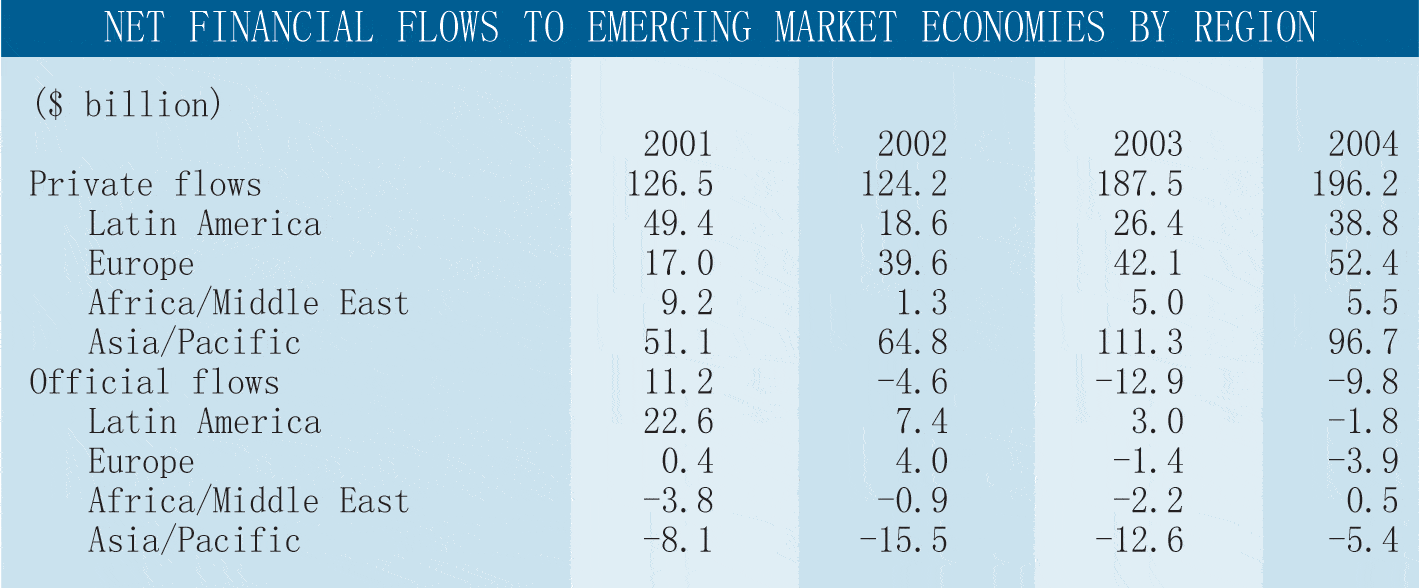The stampede to issue debt among emerging markets sovereigns and corporates is showing no signs of slowing down. Some think investors may get burned, though.

With US and UK interest ratesatrecord lows,excess global liquidity pouring into the international financial system, and credit ratings for developing countriesshowing markedimprovement, the situation is ripe for emerging market (EM) borrowers to go to the international bond markets forfinancing. Despite hefty issuance since the beginning of this year, analysts say the borrowing spree is far from over.
According to Thomson Financial, EM borrowers issued $13.7 billion in bonds on international markets in January alonethe highest level since the $15.5 billion brought to market in July 1997. The deal pipeline is still filling up nicely, with this years EM sovereign issuance expected in the region of $30 billion. Borrowers appear to be racing to lock in lower borrowing rates ahead of an expected hike in US interest rates that could tame current investor appetite for high-yield paper.
Among sovereigns coming to market in January were some traditional borrowers, including Brazil, which placed a $1.5 billion 30-year global that was upped from an initial $1 billion because of increased demand. In fact, the deal was reportedly morethan fourtimes oversubscribed, with demandsaid to have soared to near $7 billion. While US treasuries and UK gilts were yielding a mere4.03%and 4.15% respectively in mid-January, yield on the Brazilian global neared 9%.
Investors were also encouraged by Brazilian President Luiz Inacio Lula da Silvas orthodox economic policiesin spite of his populist campaign rhetoricthat have led to an official GDP growth forecast of 3% for 2004, partly supported by lower borrowing costs. Lulas popularity ratings and congressional support remain high, allowing him to also push through additional reforms that should lead to long-term growth and stability.
Markets Move Ahead of Fundamentals
Indonesias fundamentals were also whetting investor appetites, as the sovereign in January began preparing its first return to the international bond markets in seven years, with a $1 billion global bond. Investment banks have been lining up to vie for the mandate.
The most recent round of new issuance even brought deals from speculative-grade issuers, including Venezuela, with its ongoing political instability, and Turkey, with escalating budget gaps near 12%. Although many emerging market economies are improving in line with the global recovery, the situation has led some analysts to question whether or not the market may have become a little overexcited. The markets have moved way ahead of economic fundamentals, although the extent depends on the country concerned, says Keith Mullin, director of global capital markets at Thomson Financial in London. The long rally in emerging markets over 2003 was driven much more by the wall of money being thrown at them than underlying fundamentals. This dynamic drove all credit markets, not just emerging markets, he adds.
Emerging markets is still largely a sovereign market, says Mullin, noting that the lack of significant corporate issuance saved investors the effort of having to engage in credit-intensive research. As long as country fundamentals were generally moving in the right direction, investors were happy to keep buying sovereign paper. To supercharge their returns, investors moved along the maturity curve into long-dated debt, he adds.
According to a report on capital flows to EM economies by the Washington-based Institute of International Finance (IIF), despite the positive outlook for the global economy this year, there is a risk that the pickup in flows into relatively risky assets has pushed valuations to levels that are not commensurate with underlying fundamentals. The IIF predicts net private capital flows to emerging market countries will surge to $194 billion in 2004 versus $187 billion in 2003 and $124 billion in 2002. Asia is expected to attract 50% of this years flows.
Crossover Investors Boost Market
Although bond traders report the arrival of more long-term money into the EM bond scene this year, with institutional investors exploring alternatives to put their excess liquidity to work, crossover investors (those who invest in multiple asset classes) are giving analysts something to think about. The increasing presence of crossover investors poses potential risks to the emerging markets class as those investors could exit quickly because of event risk or the better performance of other asset classes, adds the IIF report.
Not all observers agree. Some cite the fact that emerging markets have attracted allocations from high-grade investors for some time, particularly in 2003, as credit spreads in G7 marketsas well as some of the cusp emerging/developed marketstightened to historical lows. While crossover inflows might appear significant in absolute dollar terms relative to total inflows into emerging markets, for many of the largest institutional asset management companies, the emerging markets allocation is actually relatively small as a percentage of total assets under management. Total value at risk is perceived therefore to lie within acceptable limits.
Mullin contends that crossover money in emerging markets contributed to a further compression in already tight spreads. The dramatic spread compression was seen in the JPMorgan EMBI+ index, which dropped to a low of 384 basis points (bps) in mid-Januarythe lowest level since the indexs introduction in 1998compared with a high of 1,040bps in late September 2002. By early February, it had only widened to 441bps, and the IIF does not expect any further compression going forward.
As spreads tightened continually over the past year, many former EM issuers effectively priced themselves out of the dedicated emerging markets investor base, says Mullin. Issuers such as Mexico attract an increasingly high-grade audience; selected Mexican corporates are targeted increasingly at US high-yield money as well as crossover investors.

|
|
|
The back-up in yields has led to a little short-term caution, but the consensus is that spreads will tighten in again over a relatively short space of time, says one observer, noting that hedge funds and speculative money had been building up to take profits by putting on short positions and were simply looking for a trigger, which the Fed unwittingly provided.
Picking the Winners
Improved creditworthiness is also supporting increased demand for EM securities. According to Standard & Poors, upgrades of sovereign credit ratings are expected to exceed downgrades this year. Furthermore, default rates among speculative-grade sovereigns are expected to remain steady.
S&P; predicts upgrades will likely be concentrated in EU and EU-accession countries, while downgrades will likely be concentrated in Latin America. Of the EU-accession countries, Estonia, Latvia, Slovenia and the Slovak Republic have positive ratings outlooks, while five of the agencys 10 sovereign ratings with negative outlooks are located in Latin America and the Caribbean.
The broad trend in recent years toward higher credit ratings of emerging market issuers has been supportive of the significant compression in spreads that has taken place since the latter part of 2002, says the IIF. The average rating of emerging market issuers is now in the double B category, which is a marked improvement from the B+ rating that prevailed in the second half of 2001. As a consequence, crossover investors have become more active in the asset class, enabling new issuance to be absorbed with little difficulty.
Emerging market fund managers still have the difficult task of picking the winners and weeding out the losers. We are very driven by country differentiation, and after deciding whether or not a country meets our criteria, we then look at each deal and ask ourselves whether it is part of a well-defined financing program or if it reflects an opportunistic behavior by the issuer; whether it is being marketed to long-term holders or to hedge funds and other short-term investors; and whether it is being priced fairly to other bonds or inappropriately, explains Mohamed El-Erian, managing director at PIMCO, a global fund manager based in Newport Beach, California.
We look at different components of risk and invest to reflect this, adds El-Erian, who says Russia is a case in point, as PIMCO maintains a dualistic analysis of the country. On the one hand, the company is concerned about the countrys corporate sector due to problems with corporate governance and inconsistency in the rule of law. So it stays clear of Russian corporate debt. On the other hand, PIMCO is comfortable with Russias sovereign risk, which El-Erian feels is more transparent and presents $80 billion in reserves, a budget surplus and a balance-of-payments surplus. Were willing to take that risk, which is quantifiable, he says.
A lot of new issuance has been in the 30-year sector, and thats a lot of duration to take on, says Kristin Ceva, senior vice president and head of the emerging market strategy group at Payden & Rydel, a Los Angeles-based institutional asset management firm. You have to look at how that fits into your portfolio. It all depends on how you feel about a countrys sovereign risk and the pricing of that particular countrys yield curve. To buy 30-year paper, you have to be comfortable with that sovereign risk, she says.
El-Erian expects to concentrate on Brazil, Panama, Peru, South Africa, Mexico and Tunisia this year and will stay away from the Philippines, which is in the midst of a difficult election process, and Uruguay, which is benefiting only from a short-term reversible bounce in neighboring Argentina. Investors, he feels, must look at the whole picture before making a decision, including how a particular credit is impacted by both internal and external factors. Buying a good house in a bad neighborhood is not a good decision, he says. We look at the neighborhood.
Santiago Fittipaldi



